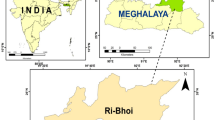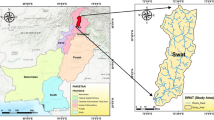Abstract
With the continuous development of loess tunnel construction in western China, there are more and more complex situations, which have received extensive attention and research. However, there is a lack of research on the interaction between tunnel excavation and land subsidence when mountain tunnel passes through the settlement area of village residents. During the excavation of Anxing tunnel through residential area, the average deformation value is as high as 202 mm, while the average deformation value of non-residential section is lower than the actual control value, and the average deformation value is 78 mm. In order to expand the survey samples, through literature statistics, it is found that among the 67 cases of large deformation of loess tunnel, 16 cases occurred considerable deformation in the residential area, accounting for 23.9%. The influence of the strength and frequency of human activities on the regional geology of residents can not be ignored and should be regarded as an independent factor. On this basis, combined with other main factors affecting the large deformation of the tunnel, a risk assessment model is established, and the influence degree of human activities and other factors on the tunnel deformation is quantitatively analyzed and verified by fuzzy analytic hierarchy process (AHP). The results show that the risk assessment grade of Anxing tunnel is graded III, and the risk assessment model of large deformation in residential area under the tunnel is in good agreement with the engineering practice. It can provide reference for the risk assessment of similar projects.
Similar content being viewed by others
References
Gao Y (2019) Study on mechanical response of shallow buried tunnel under the influence of construction mode and vehicle load. MSc Thesis, Hubei University of Technology, Wuhan, China (in Chinese)
Karwowski W, Mital A (1986) Applications of approximate reasoning in risk analysis. Advances in Human Factors/Ergonomics 6:227–243
Li B, Gao Y, Wei D, Liu H (2005) Research on the influence depth of vehicle load and its influence factors. Rock and Soil Mechanics 310–313
Liu W, Shi Z, Zhang D, Qu S (2018) Long-term settlement calculation of structural soft soil foundation under traffic load. Journal of Southeast University (Natural Science Edition) 48(4):726–735, DOI:https://doi.org/10.3969/j.issn.1001-0505.2018.04.020
Luo Y, Chen J, Gao S, Deng X, Diao P (2017) Stability analysis of super-large-section tunnel in loess ground considering water infiltration caused by irrigation. Environmental Earth Sciences 76(22):1–17, DOI: https://doi.org/10.1007/s12665-017-7106-7
Meng F, Chen R, Xu Y, Wu K, Wu H, Liu Y (2022) Contributions to responses of existing tunnel subjected to nearby excavation: A review. Tunnelling and Underground Space Technology 119:104195, DOI: https://doi.org/10.1016/J.TUST.2021.104195
Wang X, Qi X, Liu Y, Liu Z, Song F, Li C (2018) Soil structure characteristics and their effects on soil water retention under three land use types in the piedmont plain of Mount Tai. Journal of Natural Resources 33(1):63–74, DOI: https://doi.org/10.11849/zrzyxb.20161291
Wei G, Yu G, Zhang J, Zhang Z, Wang L (2019) Calculation of shear displacement of adjacent shield tunnel caused by excavation of foundation pit. Journal of the China Railway Society 41(5):149–155, DOI: https://doi.org/10.3969/j.issn.1001-8360.2019.05.018
Wu Z, Peng S, Cui F, Nie J (2019) Combining ground penetrating radar with boreholes to detect soil profile layer and water content in coal mining subsidence area. Transactions of the Chinese Society of Agricultural Engineering 35(14):243–251, DOI: https://doi.org/10.11975/j.issn.1002-6819.2019.14.031
Xu Q, Li C, Chen H, Fu Z, Wu P, Wang K (2018) Characteristics of soil moisture infiltration in karst peak-cluster sloping shrubland and terraced dry land. Transactions of the Chinese Society of Agricultural Engineering 34(8):124–131
Yang K (2020) Analysis and experimental study on soil water and fertilizer transport under different water and fertilizer application methods. MSc Thesis, Shandong Agricultural University, Taian, China (in Chinese)
Ye F, Qin N, Liang X, Ouyang A, Qin Z, Su E (2021) Analyses of the defects in highway tunnels in China. Tunnelling and Underground Space Technology 107, DOI: https://doi.org/10.1016/j.tust.2020.103658
Zhang X (2015) Numerical analysis and control measures of shallow-buried buildings in highway tunnel. Highway (7):289–293
Zhang Y, Wang C, Zhou N, Liu J (2015) Analysis of the collapse mechanism of a slope at the entrance of a loess tunnel. Chinese Journal of Underground Space and Engineering 11(S1):307–311
Zhang H, Xu G, Lin D, Zhu R (2017) Research on the mechanical difference between “house first and tunnel later” and “tunnel first and house later”. China Civil Engineering Journal 50(S2):215–219, DOI: https://doi.org/10.15951/j.tmgcxb.2017.s2.034
Zhou F (2008) Research on fuzzy hierarchical evaluation of collapse risk of mountain tunnel. MSc Thesis, Central South University, Changsha, China (in Chinese)
Acknowledgments
The authors deeply appreciate the financial support from Shaanxi Natural Science Basic Research Project (Grant no.2020JM-483) and the National Natural Science Foundation of China (NSFC) (Grant no.51408464). This paper is also funded by the China Scholarship Council.
Author information
Authors and Affiliations
Corresponding author
Rights and permissions
About this article
Cite this article
Liu, X., Yao, Z., Wan, X. et al. Research on Risk Assessment on Large Deformation of Loess Tunnels underneath Residential Areas. KSCE J Civ Eng 26, 2826–2834 (2022). https://doi.org/10.1007/s12205-022-1401-x
Received:
Revised:
Accepted:
Published:
Issue Date:
DOI: https://doi.org/10.1007/s12205-022-1401-x




